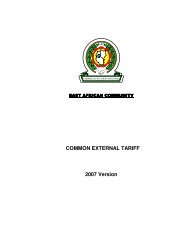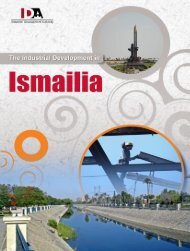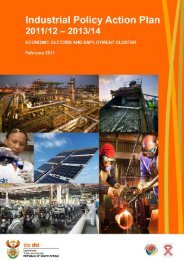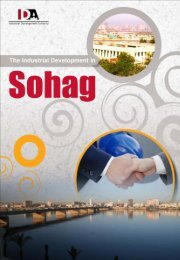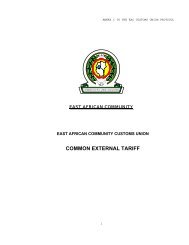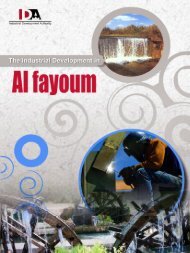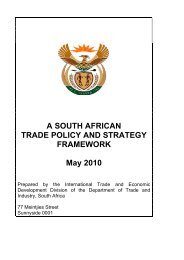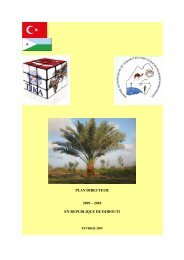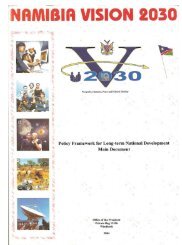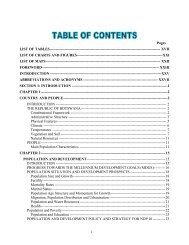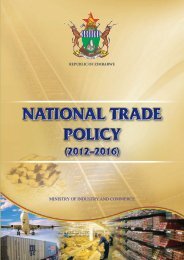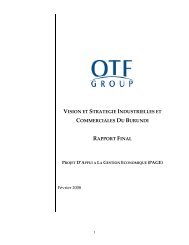rwanda national export strategy - minicom
rwanda national export strategy - minicom
rwanda national export strategy - minicom
You also want an ePaper? Increase the reach of your titles
YUMPU automatically turns print PDFs into web optimized ePapers that Google loves.
RWANDA NATIONAL EXPORT STRATEGY<br />
4.3.4 MINING<br />
The mining sector was recently privatised, which improved production levels, productivity and value<br />
addition. Export revenues increased from US$32M in 2004 to US$93M in 2008, but due to the global<br />
downturn, decreased to US$56M in 2009. Still, mining has been the largest revenue earner in terms of<br />
<strong>export</strong> products, for the past six years (2004 – 2009). In 2010, mining sector <strong>export</strong> revenues increased to<br />
US$68M.<br />
Primary minerals being extracted and traded are cassiterite (a tin ore); Colombo - tantalite (commonly<br />
called coltan - an ore that is the source of niobium and tantalum); and wolfram (a tungsten ore).<br />
Construction materials that are used in their primary state or processed include amphibolites, granites and<br />
quartzites, volcanic rocks, dolomites, clay, kaolin, sand and gravel. Peat and travertine/lime are also being<br />
exploited for energy, agriculture and cement.<br />
The sector is split between artisanal miners and mid-sized inter<strong>national</strong> companies. The government‘s key<br />
areas of focus for developing a sustainable mining sector include strengthening regulatory institutions,<br />
attracting investment, improving sector skills and practices, increasing productivity, diversification, and<br />
value addition. The sector currently employs35,000 people, and according to the director of OGMR, there<br />
is a need for 30 additional trained professionals, 4,000 technicians, and thousands of trained employees,<br />
as more than 80% of industry management states that human capital constrains the industry. Suggestions<br />
for human capital development include sending students abroad, developing lab facilities and training,<br />
creating local degrees, and installing regulation that encourages local knowledge transfer.<br />
In the medium to long-term, the industry will need to overcome challenges, such as the dearth of human<br />
capital, and high-energy costs for processing and transport. Fortunately, Rwanda also has competitive<br />
advantages, which could position her as a mining ―hub,‖ such as its relative stability, zero tolerance for<br />
corruption, and centralized position in the region. The Rwanda Mines and Geology Authority‘s strategic<br />
plan for 2010 – 2013 provides a roadmap for industry improvement. This plan addresses challenges in<br />
five core areas: 55<br />
<br />
<br />
<br />
<br />
<br />
Strengthen the enabling legal, regulatory and institutional environment;<br />
Develop competitive investment and fiscal policies for mining;<br />
Improve mining sector knowledge, skills and use of best practices;<br />
Raise productivity and establish new mines; and<br />
Diversify into new products and increase value addition.<br />
The NES addresses the <strong>export</strong> of Rwandan Mining products as well as increasing the growth of Rwandan<br />
mining services <strong>export</strong>s through initiatives such as the Mining Campus.<br />
Priority Issues and Challenges<br />
In the minerals sector, challenges to extraction remain, including difficulties accessing finance, dealing<br />
with taxes, coping with price risks, hiring inter<strong>national</strong>ly for advanced skills, and creating value-added<br />
work as compared to <strong>export</strong>ing basic materials. The main challenges are:<br />
Issue #1 Professional skills can improve. There is a dearth of skilled mining engineers, geologists<br />
and metallurgists in Rwanda, requiring companies to import skilled staff. These gaps are being addressed<br />
with efforts to train young mining professionals and attract FDI, but this will take time.<br />
Issue #2 Knowledge of reserves can be increased. The knowledge of reserves remains a major<br />
challenge, but it can be addressed by clarification and implementation of the new mining law‘s licensing<br />
55 The 2010 – 2013 Rwanda Mines and Geology Authority strategic plan aims to improve geological and mining knowledge in Rwanda, improve<br />
operating and investment condition in Rwanda, and add value to mineral and quarry resources: Source OGMR, 2010 – 2013 Strategic plan, 2010.<br />
Page 34



